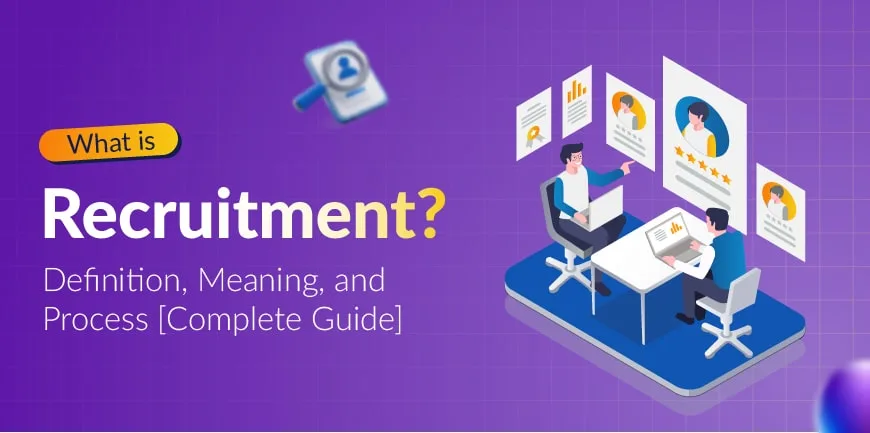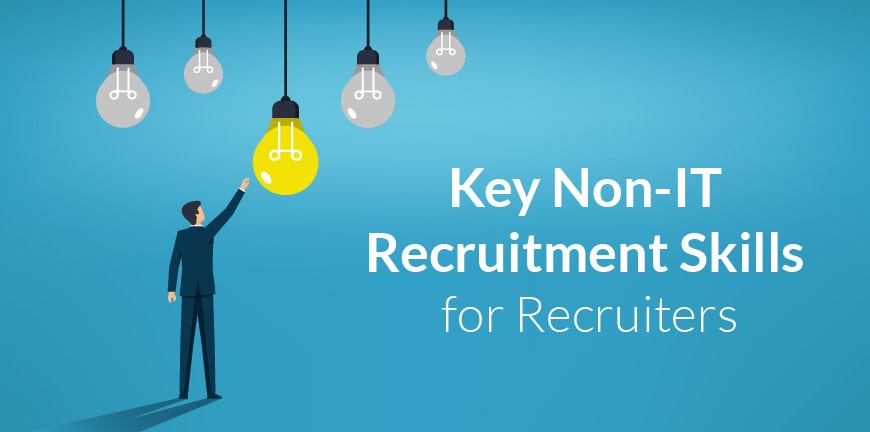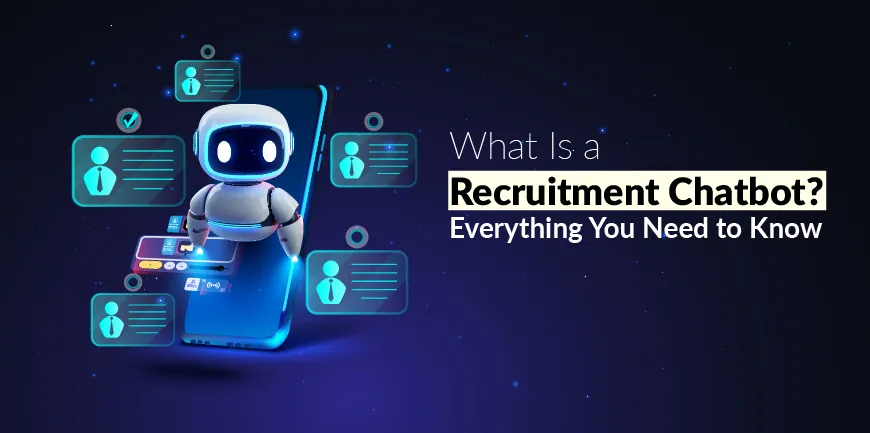
How to Choose the Right Staffing Agency: Tips and Key Factors
19/09/2025
How Blockchain is Transforming Background Verification and Hiring Trust
19/09/2025- Recruitment Ownership Across Companies
- What is Recruitment?
- What are the Components of Recruitment Process?
- Recruitment Channels
- What are the Objectives of Recruitment?
- What is the Importance of Recruitment in HRM?
- Recruitment Process [Step-by-Step]
- What are the Types of Recruitment?
- What are the Methods of Recruitment?
- What are the Challenges in Recruitment?
- Modern Trends in Recruitment (2025 and beyond)
- What are the Best Practices for Effective Recruitment?
- Recruitment vs. Staffing vs. Selection
- Recruitment vs. Staffing
- Why do these Distinctions Matter?
- Conclusion
- Key Takeaways
- FAQs on Recruitment
Recruitment today is not just about filling job positions, but also about how smartly a company can identify and attract the right kind of individuals who can drive business growth. In the new age, recruitment has become a business imperative rather than a mundane HR task. Whether you are a global enterprise or a startup, an effective recruitment process will fuel growth, boost performance, and shape your culture. Let us now walk you through the detailed recruitment journey:
Recruitment Ownership Across Companies
Recruitment responsibilities vary considerably based on organizational size and structure:
- Large organizations maintain entire teams of recruiters or separate HR departments
- Small businesses rely on a single hiring manager
- Startups and smaller firms often have founders handling recruitment directly
- Many companies outsource recruitment to professional recruiting firms or agencies
Regardless of who manages the process, recruitment functions form a key responsibility area (KRA) of human resources. The designated individuals or teams must identify and understand the company’s needs to attract potential employees qualified for available positions.
What is Recruitment?
Recruitment is a systematic process of identifying and attracting and selecting suitable professionals to fill vacant job positions within organizations. The objective is to create robust teams that align with company goals and drive long-term success.
What are the Components of Recruitment Process?
We will now take you through the various recruitment processes that involve several interconnected components working together to identify and secure the right talent. This process varies widely based on the employer, seniority, role type, and industry. Most recruitment cycles include:
- Job analysis – Determining position requirements and creating detailed job descriptions
- Sourcing – Finding and attracting qualified candidates through various channels
- Screening – Evaluating applicants based on qualifications and requirements
- Selection – Interviewing and selecting the most suitable candidates
- Hiring – Extending job offers and finalizing employment terms
- Onboarding – Integrating new employees into the organization
Recruitment Channels
Organizations utilize numerous channels to source candidates for open positions. Most companies recruit candidates for new positions via advertisements, job boards, social media sites, and professional networking platforms. Recruiters post job advertisements on company websites, online job sites, and other relevant platforms. Electronic recruitment using HR software has become increasingly popular, allowing employers to access larger pools of potential candidates.
Modern recruitment practices have evolved to include more direct engagement between job seekers and hiring managers. Rather than relying solely on automated applicant tracking systems, many professionals now use networking tools, career platforms, and industry databases to reach decision-makers more efficiently.
What are the Objectives of Recruitment?
The strategic goals that guide an organization’s efforts constitute the objectives of recruitment. These objectives serve as the foundation for a structured approach to attracting and hiring the right people. Unlike random hiring practices, strategic recruitment aligns with broader organizational ambitions to ensure each new hire contributes meaningfully to the company’s growth.
1. Strategic Alignment
Clear recruitment objectives ensure the hiring process aligns with an organization’s vision, values, and long-term goals. This strategic alignment helps companies identify and attract candidates with the necessary skills to achieve their business objectives.
According to surveys, organizations with strong recruiting practices enhance productivity by 25% compared to those without structured approaches.
2. Talent Acquisition
The primary objective of recruitment involves finding and hiring qualified individuals who possess the expertise needed to advance organizational goals. This requires creating a wide applicant pool from which the most suitable candidates are selected.
Through job portals, social media, and professional networks, businesses can scout for top talent while adapting to job market trends. LinkedIn data shows that 70% of workers worldwide are passively open to new opportunities, despite not actively searching for jobs.
3. Skills and Cultural Fit
Ensuring candidates possess the required skills for their roles remains a critical objective. This involves analyzing job standards, crafting precise job descriptions, and utilizing competency frameworks to facilitate peak performance.
Finding candidates whose values and behavior match the company’s culture constitutes another vital recruitment goal. Harvard Business Review studies indicate that 89% of hiring failures stem from poor cultural fit rather than lack of skills.
4. Workforce Planning and Cost Efficiency
Effective recruitment helps organizations identify future workforce needs based on company goals and market changes. This proactive approach allows businesses to address talent gaps before they become problematic.
Cost efficiency in recruitment involves minimizing expenses while improving hiring effectiveness. The Well-Implemented Recruitment Reports show that better recruiting processes may prevent 75% of employee turnover significantly reducing replacement costs.
5. Legal Compliance and Enhanced Performance
Organizations must follow anti-discrimination, labor, and equal opportunity regulations throughout the hiring process. This compliance reduces legal risks while enhancing the company’s reputation as a trustworthy employer. The fundamental purpose of recruitment centers is to boost organizational performance. The Boston Consulting Group found that organizations, with effective recruiting practices, increase sales 3.5 times and profit twice as much as their industry peers.
6. Diversity and Innovation
Promoting workforce diversity stands as a cornerstone objective in modern recruitment. Through inclusive hiring practices, companies seek candidates from varied backgrounds, cultures, and experiences. McKinsey & Company research reveals that companies in the top diversity quartile earn 35% higher financial returns than their sector median. This diversity fosters innovation and problem-solving capabilities.
7. Employer Branding
A robust recruitment process significantly contributes to an organization’s reputation. When candidates experience a professional, transparent hiring journey, they develop positive perceptions about the company regardless of whether they receive offers.
This positive employer branding attracts higher-quality candidates and strengthens the organization’s position in competitive talent markets.
What is the Importance of Recruitment in HRM?
Human resource management focuses on finding the right people for the right positions. The importance of recruitment in HRM extends far beyond simply filling vacant positions; it fundamentally shapes an organization’s future success.
Organizations today recognize that progress depends not on workforce quantity but on quality. Recruitment serves as the critical first step in an employee’s lifecycle, setting the foundation for everything that follows in the employment relationship.
Effective recruitment directly impacts organizational development. Research indicates that the recruitment and selection process stands as the most effective way of improving organizational development, as it shapes employee behavior and attitude by selecting candidates whose skills and experience match job specifications.
A Glassdoor study reveals that 60% of hiring managers consider a candidate’s cultural fit the most important factor in hiring decisions.
Recruitment contributes significantly to building high-performance teams. The right talent that aligns with company goals and culture ensures organizational success and reduces turnover costs. Organizations with effective recruiting practices increase sales 3.5 times and profit twice as much as their industry peers.
Effective recruitment promotes workforce diversity through inclusive hiring practices that attract candidates from varied backgrounds, cultures, and experiences. Companies in the top diversity quartile earn 35% higher financial returns than their sector median.
Efficient recruitment processes yield substantial financial benefits. Research indicates that better recruiting processes prevent 75% of employee turnover, limiting costs associated with replacements and training while freeing up resources for other strategic projects.
Recruitment plays a vital role in creating and maintaining organizational culture. Well-placed talent reinforces corporate culture and helps build a motivating and stimulating work environment. This strong culture attracts new talent and helps retain existing employees.
Recruitment contributes to brand image enhancement. Being perceived as an employer of choice attracts new talent and strengthens the company’s reputation with customers and partners. A positive brand image becomes a major asset in competitive talent markets.
Relevant recruitment processes attract varied profiles, boost creativity, and open new perspectives. This variety stimulates the innovation essential to maintaining competitiveness.
Competent, motivated staff offer better service quality, creating positive effects: customer satisfaction translates into loyalty and recommendations, which further enhance teams and the organization.
Recruitment and selection processes cannot be ignored if businesses want to stay ahead in today’s competitive environment.
Recruitment Process [Step-by-Step]
The systematic approach to finding and bringing new talent into an organization follows a structured pathway. It consists of several interconnected stages that transform a staffing need into a successful hire. Organizations across industries typically follow a similar step-by-step methodology.
1. Identifying the Hiring Need
Every recruitment cycle begins with recognizing a staffing requirement within the organization. This need arises from vacant positions, expanding workloads, or creating entirely new roles to support organizational growth.
2. Developing a Recruitment Plan
Once a hiring need is established, the next step involves creating a structured recruitment strategy. This plan outlines how the position aligns with organizational objectives, who will participate in the hiring decision, selection criteria, and the methods used to publicize the opportunity.
3. Creating Job Descriptions
Recruiters generate detailed job descriptions that outline required qualifications, preferred skills, experience levels, and compensation information. The job description serves as the foundation for attracting suitable candidates. Many organizations now employ generative AI to craft descriptions focused on necessary skills while avoiding biased language.
Sourcing Candidates After finalizing the job description, organizations begin attracting potential candidates through various channels:
- Company career portals and websites
- Job boards and professional networks
- Social media platforms
- Career fairs and industry events
- Employee referral programs
- Internal talent pools
- Recruitment agencies
4. Screening Applications
This stage involves evaluating candidates based on their qualifications. The screening process typically includes resume reviews, followed by initial phone interviews or chatbot interactions to assess basic requirements and align expectations.
5. Interviewing Qualified Candidates
Candidates who successfully pass the screening phase advance to formal interviews. This might include several rounds, from initial one-on-one discussions to panel interviews with potential team members and executives. Some positions require additional assessment tests measuring technical skills, emotional intelligence, or problem-solving abilities.
6. Selection and Background Verification
After interviews conclude, hiring teams identify their top choice and potentially backup candidates. Many organizations conduct background checks and reference verifications to confirm previous employment details and validate information provided by candidates.
7. Extending Job Offers
Once the ideal candidate is selected, the organization extends a formal job offer including details about salary, benefits, time off, start date, working arrangements, and other employment terms. This often involves negotiation before reaching a final agreement.
8. Onboarding New Employees
The final stage involves welcoming and integrating the new hire into the organization. Effective onboarding goes beyond paperwork completion. It encompasses workplace orientation, team introductions, equipment setup, and initial training.
What are the Types of Recruitment?
Organizations employ various recruitment approaches to build their workforce. Understanding the different types of recruitment helps HR professionals select the most appropriate method for specific hiring needs.
Internal Recruitment refers to filling job vacancies from within the organization’s existing workforce. This approach involves sourcing talent from other teams, departments, and job functions within the company. Internal recruitment is typically faster and more cost-effective than external methods, as it eliminates many common recruitment expenses such as job board fees and agency costs.
Internal recruitment happens through several channels:
- Transfers – Moving employees between departments, locations, or projects without significant changes in roles and responsibilities
- Promotions – Upgrading employees to higher positions with increased responsibilities and compensation
- Re-employment – Hiring former employees who left on good terms or calling retired employees for specific roles
- Internships – Converting interns into full-time employees after assessing their performance
Internal hiring demonstrates confidence in existing staff abilities and shows clear career development pathways. It boosts employee motivation and loyalty while reducing onboarding time since employees already understand the company culture and processes.
External Recruitment involves hiring candidates from outside the organization. Provides access to a substantially larger talent pool and brings fresh perspectives into the company. External candidates contribute new skills, experiences, and insights about industry practices that might not exist within the current workforce.
Both approaches offer distinct advantages and limitations. While internal recruitment limits the candidate pool, external recruitment typically costs more time and money. Many organizations employ a combination of both strategies to create a well-rounded workforce.
Specialized recruitment types exist beyond these two primary categories:
1. Staffing Recruitment
Focuses on filling short-term or temporary positions without long-term commitments
2. Outplacement Recruitment
Helps former employees transition to new roles while maintaining positive relationships
3. Reverse Recruitment
Involves recruiting employees directly from competitors to gain industry knowledge
4. Retained Recruitment
Engages recruiting firms to handle the entire process, regardless of outcome
5. Contingency Recruitment
Utilizes recruiting firms that receive payment only upon successful placement
The choice between recruitment types depends on organizational needs, position requirements, market conditions, and business objectives. Emerging technologies continue to reshape how companies approach each recruitment type, with AI-powered tools streamlining candidate sourcing, screening, and selection across all methods.
The goal remains consistent across the recruitment spectrum: finding qualified individuals who can contribute effectively to organizational success while aligning with company culture and values.
What are the Methods of Recruitment?
The toolkit of techniques that recruiters use to source and attract talent has evolved dramatically over time. The methods encompass the specific approaches and channels organizations utilize to identify, attract, and engage potential candidates for open positions.
1. Traditional Recruitment Methods
Organizations relied on conventional recruitment techniques that formed the foundation of hiring practices for decades. Print advertising in newspapers and job boards served as primary channels for reaching wide pools of potential candidates. Local employment offices and temp agencies acted as intermediaries to help businesses find qualified applicants. Headhunting through personal connections and networks allowed companies to target specific individuals with desired qualifications.
These established approaches provided familiarity to both employers and candidates. In-person interviews remained the standard for evaluating candidates, coupled with thorough resume and cover letter reviews. Many organizations implemented employee referral programs, encouraging staff to recommend friends or colleagues for open positions—often resulting in more reliable and successful hires.
Traditional methods offered clear advantages through their established processes that ensured fairness and consistency. However, they typically reached limited candidate pools, consumed significant time, and sometimes introduced unconscious bias into hiring decisions.
2. Modern Recruitment Methods
Technological advancements have transformed how organizations source and engage talent in a systematic and orderly way. Artificial Intelligence (AI) technology now streamlines complex recruitment processes, automating candidate screening while using fewer resources than previous approaches. Companies have adopted mobile optimization for recruitment, providing instant access to candidates, particularly millennials and Generation Z.
Social media platforms have become powerful recruitment channels, with 91% of recruiters planning to use platforms like Facebook and Twitter to advertise job openings. Applicant Tracking Systems (ATS) enable recruiters to automate time-consuming administrative tasks, collecting applicant data and ranking candidates based on qualifications.
Virtual reality technology allows organizations to engage with prospects through three-dimensional meetings and virtual workplace tours. Company reviewing platforms enable candidates to research potential employers before applying, learning about workplace culture and organizational principles.
Other approaches include virtual personality assessments to determine cultural fit, search engine optimization tools for constructing effective job descriptions, and recruitment marketing strategies to attract passive candidates.
3. Comparative Advantages
Modern recruitment methods enhance efficiency through automated tools like ATS, connect recruiters with diverse global audiences, and improve candidate experiences through seamless communication. They reduce costs over time while providing data-driven insights to refine hiring strategies.
Many organizations now implement hybrid approaches, combining elements of both traditional and modern methods. Companies might use online job boards and AI-powered screening to identify qualified candidates, then conduct in-person interviews to assess cultural fit and interpersonal skills for final selections.
Effective recruitment requires selecting methods that align with organizational needs, position requirements, market conditions, and business objectives. Technology continues to advance recruitment methods, creating more sophisticated approaches to talent acquisition that serve as business-first solutions for workforce development.
What are the Challenges in Recruitment?
The complexities of talent acquisition present numerous obstacles for modern recruitment teams. Even with robust strategies in place, hiring professionals often encounter roadblocks that can impact on the most carefully planned recruitment efforts.
- Finding qualified candidates remains a primary hurdle, with 87% of companies projected to experience skills gaps in key areas by 2025. Specialized fields like healthcare, technology, and engineering face the most severe talent shortages. This challenge intensifies as businesses increasingly require advanced skills in artificial intelligence, machine learning, and cybersecurity.
- Today’s competitive market creates talent competition that adds pressure as great candidates field multiple offers simultaneously. Recruiters must work diligently to make their opportunities stand out. Meanwhile, 81% of employers struggle with managing remote teams effectively, complicating how organizations hire, manage, and retain distributed workforces.
- Time constraints present another significant obstacle. Recruiters commonly report having hundreds of emails and applications to process daily—sometimes up to 2,000 for just 10 open positions. This volume makes thorough candidate evaluation extremely challenging.
Additional recruitment obstacles include:
- Unconscious bias affecting hiring decisions and limiting workforce diversity, despite 67% of job seekers considering diversity a crucial factor when choosing employers
- Technical knowledge gaps among recruiters when explaining complex job specifications to passive candidates
- Lengthy hiring processes are causing candidate drop-off, with 60% of job seekers abandoning long application procedures
- Communication breakdowns between recruiters, hiring managers, and candidates are creating delays and poor experiences
- Budget limitations restricting access to premium recruitment tools and platforms
The evaluation process itself presents challenges. Many recruiters find it difficult to accurately test candidates’ skills before hiring. This issue becomes especially pronounced when hiring managers maintain overly selective criteria, creating unrealistic expectations that few candidates can meet.
Employer branding in a competitive market adds another layer of complexity, with 72% of recruiting leaders believing it significantly impacts hiring success. Organizations with weak employer brands often lose top talent to competitors offering better workplace cultures or career opportunities.
Successfully addressing these obstacles determines whether organizations can secure the talent needed to thrive in today’s dynamic business landscape.
Modern Trends in Recruitment (2025 and beyond)
The recruitment landscape continues evolving rapidly as we move through 2025 and beyond, with technological advancements reshaping how organizations attract and select talent. stands at the forefront of this transformation, allowing recruiters to streamline repetitive tasks and focus on strategic activities like building relationships and improving candidate experience.
- AI adoption among recruiting teams is growing steadily, with 37% of organizations now actively integrating or experimenting with generative AI tools, up from 27% a year ago. Efficiency drives this adoption—teams using generative AI save approximately 20% of their work week, equivalent to a full workday saved weekly.
- Talent intelligence platforms have emerged as game-changers. These sophisticated systems use advanced algorithms to analyze vast amounts of data from multiple sources, creating a holistic view of the talent landscape. This enables organizations to make more informed decisions and build robust talent pipelines before critical needs arise.
- The concept of a hybrid workforce has evolved considerably, with organizations now building entire talent acquisition strategies around this model. Employers prioritize location flexibility, with more than one-third of companies willing to hire remote workers from anywhere in the world.
- Skills-based hiring has become increasingly crucial, with nearly 24% of survey respondents identifying finding the right skills as a top challenge for 2025. Organizations now implement skills assessment frameworks that go beyond traditional certifications, incorporating continuous learning and development tracking.
- Extended Reality (XR) technologies have revolutionized candidate experiences, allowing virtual office tours where candidates can interact with potential team members and participate in simulated work scenarios. AI-powered chatbots are helping to convert more applicants, with career sites utilizing chatbots seeing a 95% increase in conversions to leads and a 40% rise in completed applications.
- Mobile optimization remains essential, as candidates expect seamless experiences regardless of device. Supporting employee health and well-being has become a top focus for talent attraction, with 64% of employers identifying it as a key strategy to increase talent availability.
- Diversity initiatives continue to gain momentum, with 83% of employers now reporting that they have such initiatives in place, compared to 67% in 2023. This reflects growing recognition that expanding talent availability through diverse talent pools offers significant advantages.
What are the Best Practices for Effective Recruitment?
If you are an organization seeking to build an exceptional workforce, you require proven talent that delivers results in competitive talent markets. These recruitment practices focus on quality outcomes and create meaningful candidate experiences that strengthen your talent pipeline.
1. Create Compelling Job Descriptions
Job descriptions serve as the foundation for attracting suitable candidates to your organization. Effective listings emphasize growth opportunities and outcomes rather than just responsibilities, focusing on what makes someone successful in the role.
2. Treat Recruitment as Strategic Business Planning
Forward-thinking organizations approach recruitment as an ongoing strategy rather than a reactive task. This systematic and streamlined approach helps identify future workforce needs, set hiring goals, and develop robust talent pipelines.
3. Optimize Job Postings for Maximum Visibility
Job posting optimization extends beyond basic requirements. Clear, straightforward titles that match what candidates search for. Organizations focusing on skills-based hiring can increase their talent pool by 10 times, according to LinkedIn data.
4. Maintain Clear Communication Throughout
Communication remains vital throughout the recruitment process. Poor communication causes 60% of candidates to abandon applications. Using applicant tracking systems to automate updates keeps candidates informed at every stage, creating positive experiences regardless of hiring outcomes.
5. Utilize Employee Referral Programs
Employee referrals stand among the most effective recruitment methods, being four times more likely to result in successful hires. The interview experience significantly influences job acceptance decisions, with 77% of candidates rating it extremely important.
6. Showcase Company Culture Through Video Content
Recruitment videos effectively showcase company culture before candidates even apply. At companies with more than 1,000 employees, 70% use video content as part of their talent acquisition efforts.
7. Build Long-term Talent Relationships
Past job applicants represent valuable potential talent for future opportunities. Although they might not have been the right fit previously, they could be suitable for future openings. Maintaining connections with promising candidates through applicant tracking systems creates ready-made talent pools when business needs arise.
These systematic approaches help organizations secure the talent needed to achieve their business objectives while building positive employer reputations in competitive markets.
Recruitment vs. Staffing vs. Selection
Organizations often use recruitment, staffing, and selection interchangeably, yet these represent distinct processes within the human resources framework. Each serves unique functions in building an organization’s workforce.
Recruitment vs. Selection
Recruitment and selection form two sequential stages in the hiring process. Recruitment focuses on attracting qualified candidates to apply for vacant positions, while selection involves identifying the most suitable candidate from this applicant pool.
These processes differ fundamentally in several ways:
| Aspect | Recruitment | Selection |
| Stage | First stage | Second stage |
| Approach | Positive (attracting candidates) | Negative (rejecting unsuitable candidates) |
| Complexity | Simpler process | More complex with various tests and phases |
| Resource Usage | Less time-consuming and expensive | Often time-consuming and expensive |
| Legal Relationship | No contractual relationship established | Creates a contractual agreement between the company and the candidate |
Recruitment vs. Staffing
Staffing entails a broader scope than recruitment. Staffing involves the comprehensive management of an organization’s workforce, ensuring the right people occupy the right positions at the right time.
Staffing represents a continuous, long-term process that includes recruitment as just one component. Staffing extends beyond hiring to include workforce planning, employee orientation, training, development, performance management, and succession planning.
Staffing often address temporary, contractual, or permanent roles based on business needs, while recruitment typically focuses on filling permanent positions.
Why do these Distinctions Matter?
Understanding these differences enables organizations to develop appropriate strategies for each process. When implemented correctly, these interconnected processes help companies reduce attrition, increase productivity, and improve financial outcomes.
Conclusion
Recruitment is a cornerstone of organizational success, extending well beyond filling vacant positions. Effective recruitment directly impacts business performance, company culture, and long-term growth. Organizations that master recruitment processes gain significant competitive advantages in their industries.
The recruitment landscape will continue evolving, but its fundamental purpose remains unchanged: connecting the right people with the right opportunities at the right time. Organizations that view recruitment as a strategic investment rather than an administrative function will thrive, building teams capable of driving innovation, productivity, and sustainable growth.
Key Takeaways
Understanding recruitment fundamentals and implementing strategic practices can transform your organization’s ability to attract and retain top talent.
- Recruitment is strategic, not reactive – Treat hiring as an ongoing investment in human capital rather than a last-minute response to vacancies.
- AI and technology streamline processes – Organizations using AI save 20% of their work week while improving candidate experience and decision-making.
- Skills-based hiring expands talent pools – Focus on competencies over credentials to increase your candidate pool by 10 times.
- Internal recruitment boosts retention – Promoting from within demonstrates career growth opportunities and reduces turnover by up to 75%.
- Candidate experience drives success – Poor communication causes 60% of applicants to abandon the process, making transparency essential.
- Diversity initiatives deliver results – Companies in the top diversity quartile earn 35% higher financial returns than industry medians.
FAQs on Recruitment
1. What is the main purpose of recruitment in an organization?
The primary purpose of recruitment is to identify, attract, and hire qualified candidates to fill specific positions within an organization.
2. How has technology impacted modern recruitment practices?
Technology has significantly transformed recruitment, with AI streamlining processes, mobile optimization improving accessibility, and virtual reality enhancing candidate experiences.
3. What are some common challenges faced during the recruitment process?
Common recruitment challenges include finding qualified candidates in competitive markets, managing unconscious bias, dealing with time constraints, and navigating lengthy hiring processes.
4. How does internal recruitment differ from external recruitment?
Internal recruitment involves filling job vacancies from within the organization’s existing workforce, while external recruitment seeks candidates from outside the company.
5. What are some best practices for effective recruitment?
Effective recruitment practices include creating compelling job descriptions, treating recruitment as an ongoing strategy, optimizing job postings for visibility, and maintaining clear communication throughout the process.
Contact Us For Business Enquiry

Amit Saproo
Amit Saproo is the Head of Operations at ALP Consulting with nearly 17 years of experience in Executive Search, RPO, Leadership, and IT & Engineering recruitment. He leads nationwide recruitment programs across Technology, BFSI, and R&D domains, driving strategic hiring solutions for diverse client needs. Amit excels in building and managing high-performance teams that deliver scalable, end-to-end recruitment and consulting services.




